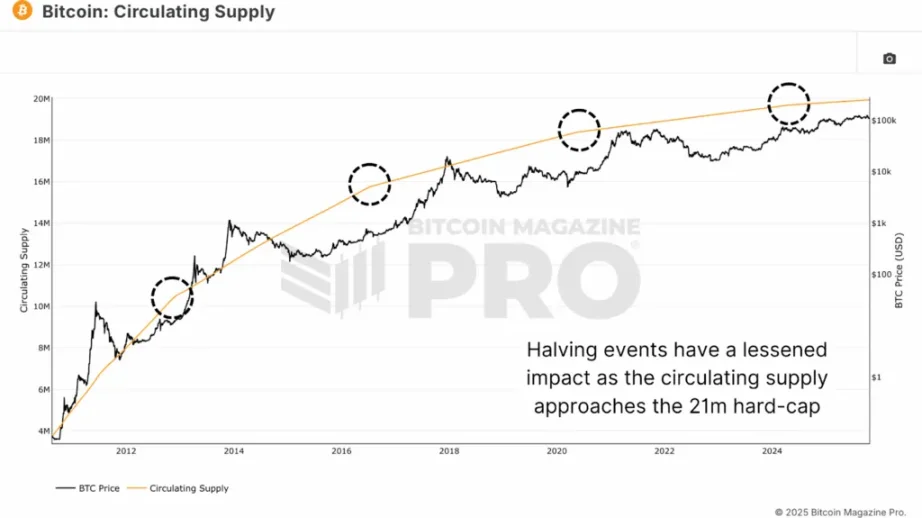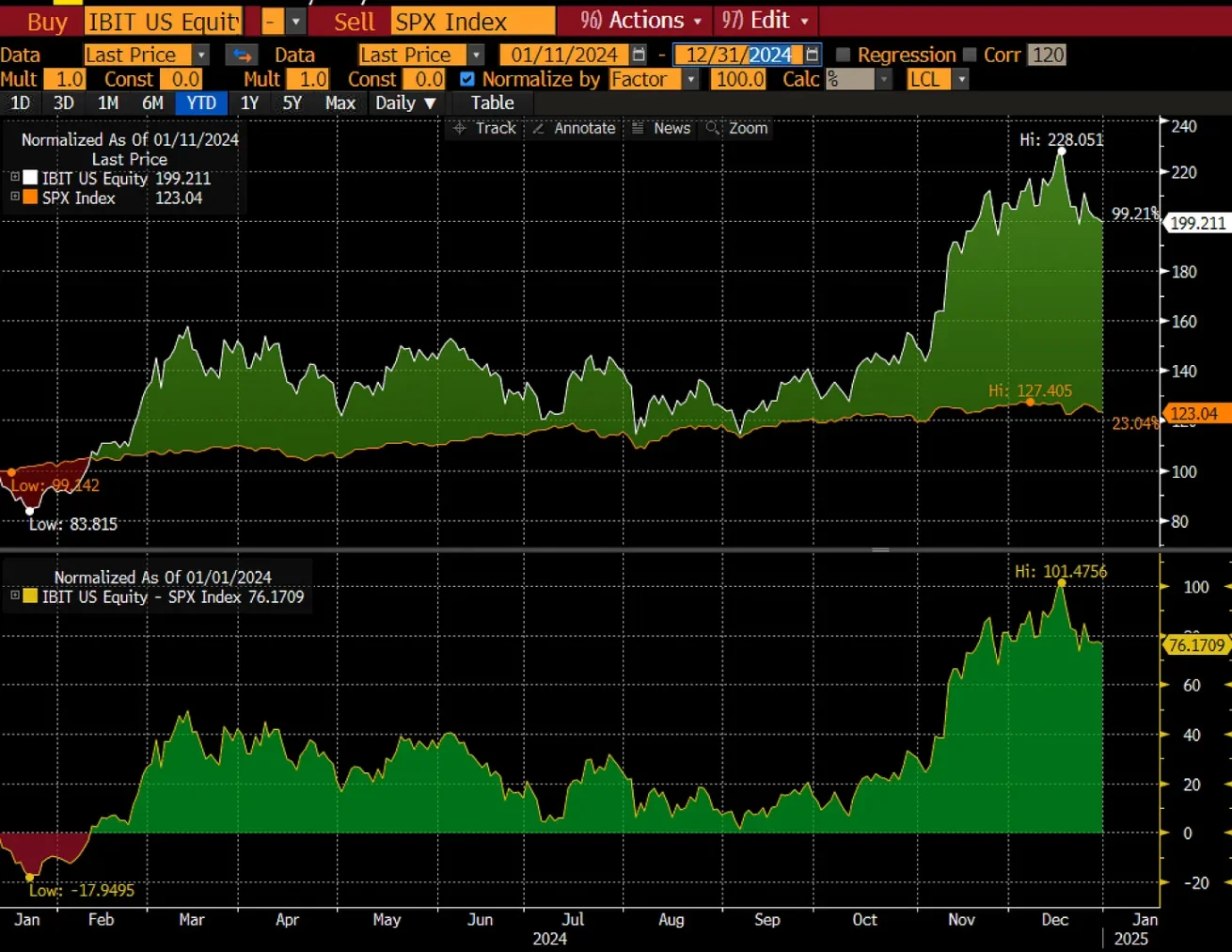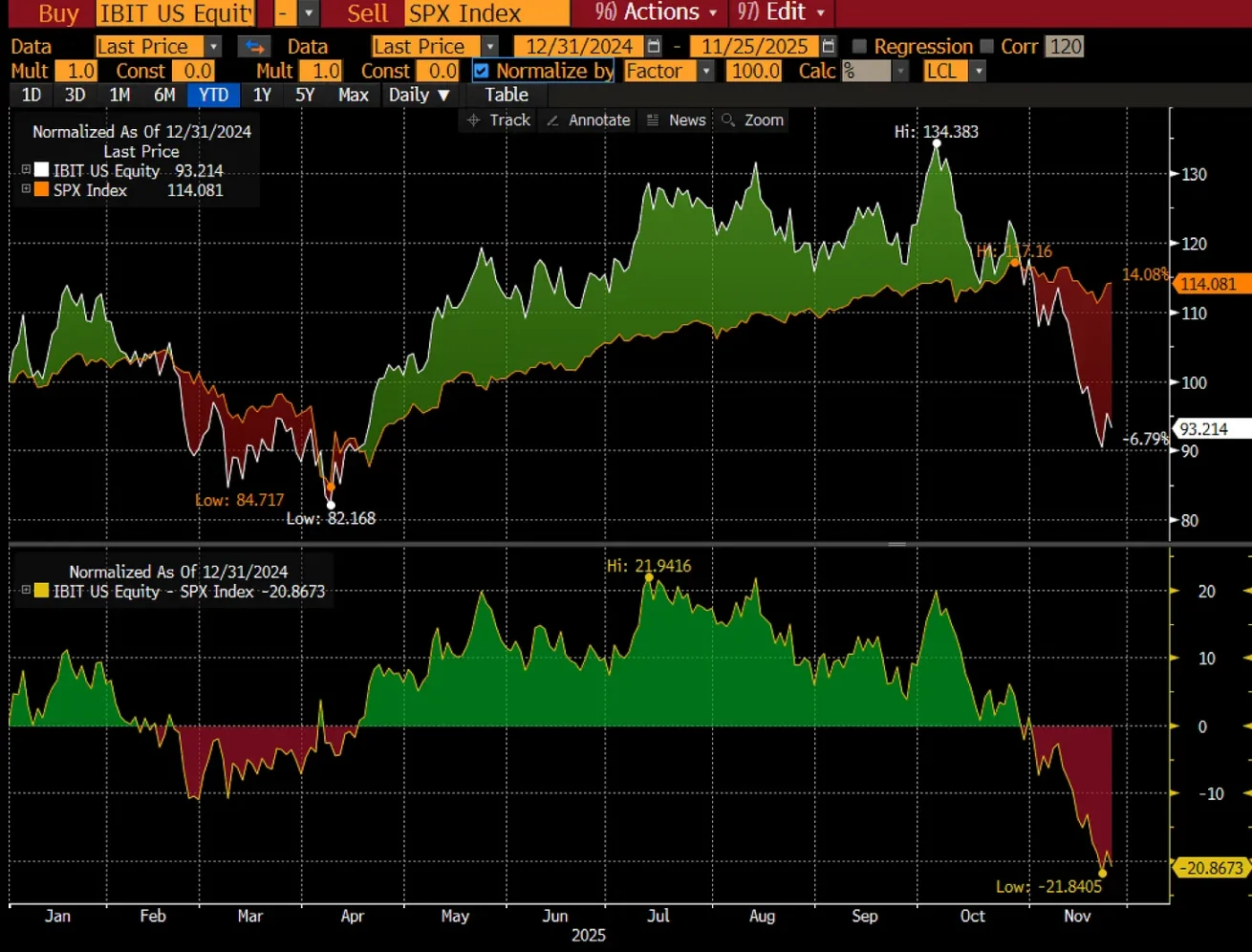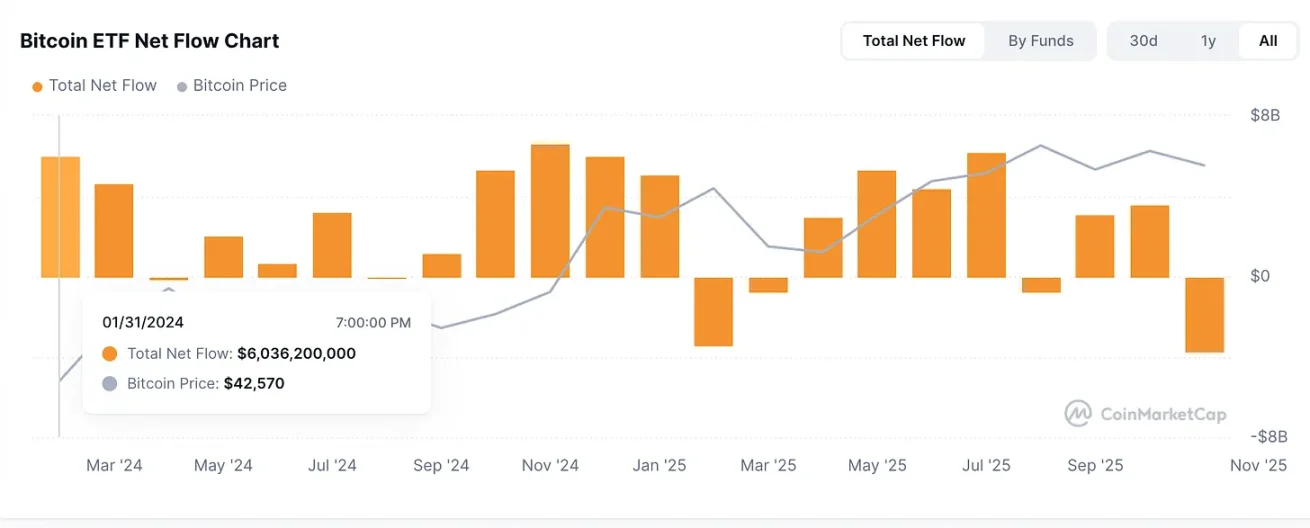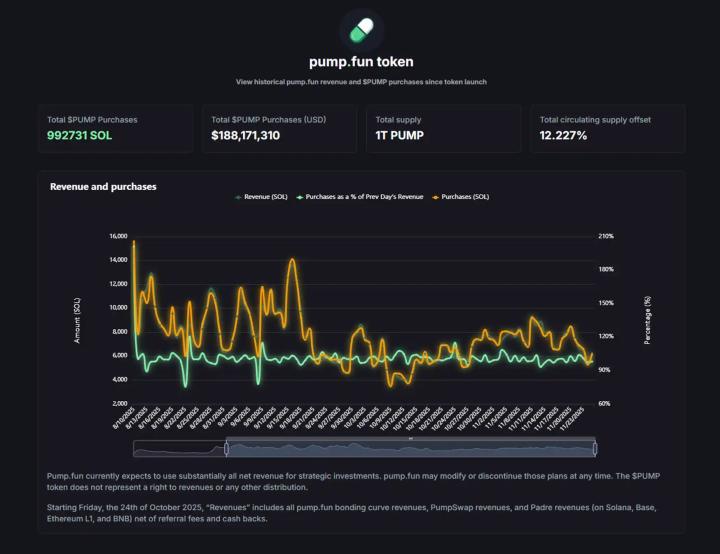Author: Jeff Park
Compiled by: AididiaoJP, Foresight News
Original title: Bitcoin's four-year cycle has ended, replaced by a more predictable two-year cycle.
Bitcoin has historically followed a four-year cycle, which can be described as a combination of mining economics and behavioral psychology.
Let's first review what this cycle means: Each halving mechanically reduces new supply and tightens miner profit margins, forcing weaker participants out of the market and reducing selling pressure. This then reflexively increases the marginal cost of new BTC, resulting in a slow but structural supply tightening. As this process unfolds, fervent investors anchor themselves to the predictable halving narrative, creating a psychological feedback loop. This loop is: early positioning, price surge, viral spread through media attention, retail FOMO, ultimately leading to leveraged frenzy and a crash. This cycle works because it's a combination of programmatic supply shocks and reflexive herding behavior that it seems reliably triggered.
But that was the Bitcoin market of the past.
Because we know that the supply component in the equation is less effective than ever before.
Bitcoin's circulating supply and the impact of diminishing marginal inflation
So what should we expect from the future?
I propose that in the future, Bitcoin will follow a "two-year cycle," which can be described as a combination of fund manager economics and behavioral psychology dominated by ETF footprints. Of course, I make three arbitrary and controversial assumptions here:
Investors are evaluating their Bitcoin investments within a one- to two-year timeframe (rather than longer, as this is how most asset management firms operate in the context of liquid fund management. These are not closed-end private/venture capital structures holding Bitcoin. It also makes no exception for assuming that financial advisors and registered investment advisors operate under a similar framework).
In terms of "new sources of liquidity injection", the flow of funds from professional investors through ETFs will dominate Bitcoin's liquidity, and ETFs will become a proxy indicator that needs to be tracked.
The selling behavior of veteran whale remains unchanged/not considered as part of the analysis, and they are now the largest supply determinants in the market.
In asset management, there are several important factors that determine cash flow. The first is co-owner risk and year-to-date profit or loss.
Regarding co-owner risk, this refers to the concern that "everyone holds the same thing," meaning that when liquidity is unidirectional, everyone needs to engage in the same transactions, thus exacerbating potential price movements. We typically see this in sector rotation (theme-driven), short squeezes, pair trading (relative value), and erroneous M&A arbitrage/event-driven scenarios. However, we also commonly see this in multi-asset scenarios, such as in CTA models, risk parity strategies, and of course, in fiscally driven trades where stocks represent asset inflation. These dynamics are difficult to model, requiring extensive proprietary information about positions, making them inaccessible or difficult for the average investor to understand.
However, what is easy to observe is the profit and loss since the beginning of the year in point 2.
This is a phenomenon in the asset management industry, which operates on a calendar year cycle, as fund fees are standardized annually based on performance as of December 31st. This is particularly evident in hedge funds, which need to standardize their carried equity before the end of the year. In other words, as volatility increases towards the end of the year, and fund managers do not have sufficient "locked-in" profits or losses as a buffer earlier in the year, they are more sensitive to selling their riskiest positions. This relates to whether they will get another chance in 2026 or be laid off.
In "Fund Flows, Price Pressures, and Hedge Fund Returns," Ahoniemi & Jylhä document how capital inflows mechanically drive up returns, which in turn attract additional inflows, eventually reversing the cycle—a process that takes nearly two years to complete. They also estimate that approximately one-third of hedge fund reports are actually attributable to these flow-driven effects, rather than managerial skill. This provides a clear understanding of the underlying cyclical dynamics that shape returns to a greater extent than simply the performance of underlying strategies, determining the latest inflows into the Bitcoin asset class.
Therefore, with this in mind, consider how fund managers would evaluate positions like Bitcoin. Facing their investment committee, they would likely argue that Bitcoin's compound annual growth rate is around 25%, thus requiring a compound growth rate exceeding 50% over that timeframe.
In Scenario 1 (from its inception to the end of 2024), Bitcoin rose by 100% in one year, which is excellent. Assuming Saylor's proposed 30% CAGR over the next 20 years is the "institutional threshold," then a year like this achieves 2.6 years' worth of performance ahead of schedule.
However, in scenario 2 (early 2025 to date), Bitcoin has fallen by 7%, which is not good. These are investors who entered the market on January 1, 2025, and are now at a loss. These investors now need to achieve a return of more than 80% in the next year, or a return of 50% in the next two years, to reach their threshold.
In Scenario 3, investors who have held Bitcoin since inception until now/end of 2025 have seen their returns increase by 85% in approximately two years. This is slightly higher than the 70% return required to achieve a 30% CAGR within that timeframe, but not as much as when they observed this point on December 31, 2025. This raises a crucial question for them: Should I sell now to lock in profits, reap my rewards, and secure the win, or let it continue to grow?
At this point, rational investors in the fund management business would consider selling. This is because of the reason I mentioned above, namely...
Cost standardization
Protect reputation
This combines "risk management" with a premium service that demonstrates a continuous flywheel effect.
So what does this mean?
Bitcoin is now approaching an increasingly important price level of $84,000, which is the total cost basis of the ETF since its inception.
But this picture alone is not complete. Take a look at this chart from CoinMarketCap, which shows the net cash flow each month since its inception.
As you can see here, most of the positive profits and losses came from 2024, while almost all ETF inflows were in the red in 2025 (except for March). This is especially true considering that the largest monthly inflows occurred in October 2024, when Bitcoin's price had already reached $70,000.
This can be interpreted as a bearish scenario because investors who invested the most capital at the end of 2024 but haven't yet reached their return threshold will face a decision-making point in the following year as their two-year cycle comes to an end. Those who invested in 2025 will need to perform exceptionally well in 2026 to catch up, which could lead them to exit prematurely, especially if they believe they can achieve higher returns elsewhere. In other words, if we enter a bear market, it's not because of the four-year cycle, but because the two-year cycle has never allowed fund managers' new capital to enter at a suitable entry point relative to exiting investors' profit-taking.
In October 2024, the closing price was $70,000. In November 2024, the closing price was $96,000. This means that when the one-year period comes to an end, their thresholds are set at $91,000 and $125,000 respectively (I admit this is too rough because it doesn't take into account monthly prices and needs more appropriate adjustments). If you apply a similar approach to June 2025 (which is the month with the largest year-to-date inflows), then a price of $107,000 means that by June 2026, $140,000 will become a threshold. You will either reach it successfully or fail again. By now, you can probably intuitively understand that comprehensive analysis combines all these money flows with a time-weighted average.
As shown below, we are at an inflection point, and if it drops 10% from here, the assets under management of the Bitcoin ETF could return to the level we were at at the beginning of the year ($103.5 billion).
All of this underscores the growing importance of monitoring not only the average cost base of ETF holders, but also the moving average of that profit and loss by entry date. I believe these will become more significant sources of liquidity supply and circuit breaker pressures in future Bitcoin price action than the historical four-year cycles. This will result in a "dynamic two-year cycle."
The second crucial conclusion here is that if Bitcoin's price doesn't fluctuate, but time marches on (which it will be, whether you like it or not!), this is ultimately detrimental to Bitcoin in the institutional era because fund managers' returns are declining. Asset management is a business about "cost of capital" and relative opportunity. So if Bitcoin's returns decline, not because it's rising or falling, but because it's consolidating, it's still unfavorable for Bitcoin and will lead investors to sell when its returns are compressed below 30%.
In short, the four-year cycle has certainly ended, but the fading of old tricks doesn't mean there are no new ones to play. Those who understand this particular behavioral psychology will find a new cycle that can function. This is more difficult because it requires a more dynamic understanding of capital flows within a cost-based context, but ultimately, it will reaffirm the truth about Bitcoin: it will always fluctuate based on marginal demand and supply, as well as profit-taking behavior.
The only difference is that the buyers have changed, and supply itself has become less important. The good news is that these buyers, acting as intermediaries for others' funds, are more predictable, and the fact that supply constraints are less important means that more predictable factors will become more dominant.
Twitter: https://twitter.com/BitpushNewsCN
BitPush Telegram Community Group: https://t.me/BitPushCommunity
Subscribe to Bitpush Telegram: https://t.me/bitpush


